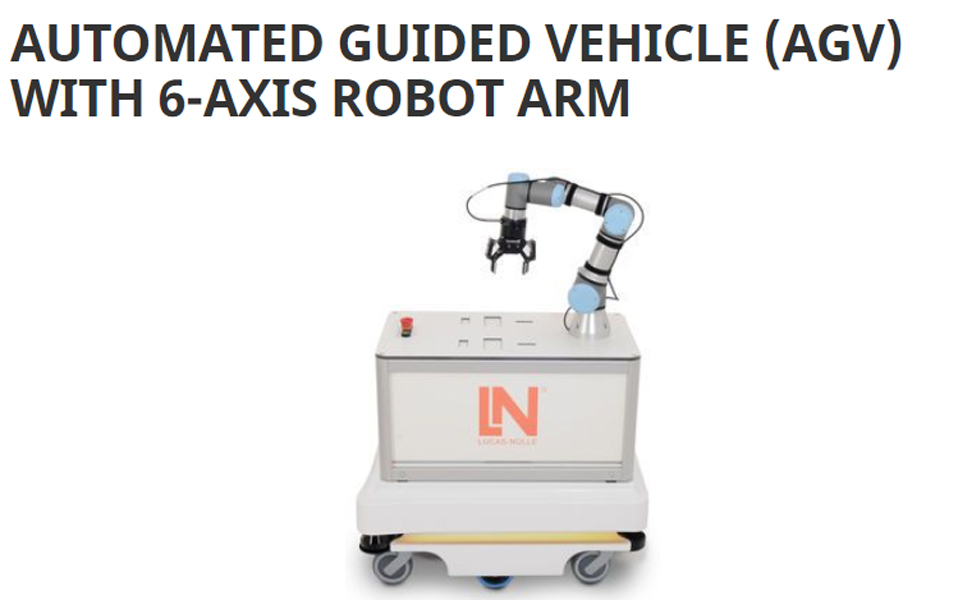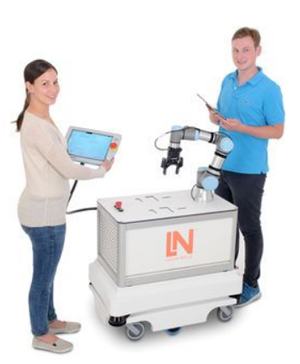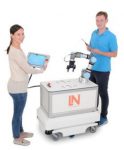CAV 1 AUTOMATED GUIDED VEHICLE SYSTEM WITH COLLABORATIVE ROBOT ARM


In modern companies more and more automated guided vehicle systems (AGV) are being put into operation. The orientation of the AGV system is realised using integrated cameras and sensors to scan the surroundings. By comparing the surroundings with the previously created map thereof, the AGV can safely navigate this space.
The collaborative robot arm permits customised project planning. This means that the AGV is not restricted to merely being a transport or vehicle system. Several project deployments can be realised by the AGV and the collaborating robot arm such as the transportation and delivery of finished products by the AGV to the transportation department or retrieval of special production goods from the custom finishing bay.
Automatically guided robots
- Payload: 100 kg
- Accuracy: within +- 10 mm of dock markings
- Maximum speed: 1.5 m/s
- Battery charging time: 0–80%: 2 hours
- Communication: WiFi, Bluetooth, Ethernet and PLC
- Power Supply: 100–230 V AC, 50–60 Hz
Safety systems (compliant with safety requirements of EN 1525, SICK safety laser scanner, PL d cat. 3):
- 2 SICK laser scanners: optical 360° protection
- 2 3D-cameras: Detection of obstacles on route, 50–500 mm above floor
- 4 Ultrasonic scanners: detection of transparent objects on route, e.g. glass doors
Collaborative 6-axis robot arm with gripper and built-in camera system
The robot is easy to program, can be configured rapidly and is designed for safe, collaborative operation. Thanks to the intuitive software, even inexperienced operators can quickly learn the programming basics. Desired route markers are specified so that the robot arm can be moved to the correct position.
Technical data:
- Operating radius: 500 mm
- Payload: 3 kg
- Repetition accuracy: +/- 0.1 mm
- Operation: 12″ touchscreen with user-friendly graphic user interface
- Degrees of freedom: 6 rotating joints
- I/O interfaces: 16 digital inputs, digital outputs, 2 analog inputs, 2 analog outputs
- Electric gripper: adjustable gripping force, 3N to 40N, reach up to 110 mm
- Camera system: maximum resolution: 5 Mpx (2560 x 1920), maximum image frequency: 30 fps
- Safety: Test of safety functionality carried out and certified by TÜV NORD in compliance with EN ISO 13849:2008 PL d
Included accessories:
2 VL markers made of powder-coated aluminium
1 training panel comprising a Bluetooth module for connecting a controller with the following specifications:
- Bluetooth 4.0
- 1 digital 24V input
- 4 digital relay outputs (changeover contacts) with LED status display
- Supply voltage: 100-230 V AC, 50-60 Hz
Complete system’s technical data:
- Dimensions: 1000 x 600 x 850 mm (H x W x D)
- Weight: 130 kg
This system consists of a collaborative-operation, automated guided vehicle (AGV) robot with an additional 6-axis robot arm, which is also collaborative. This new generation of autonomously operating, mobile robots is currently revolutionising the way that companies transport materials within their facilities. Safe operation of such automated guided vehicle (AGV) is ensured using camera-based systems and does not require magnetic loops to be installed in the floor.
The mobile robots safely maneuver themselves around people and obstacles autonomously. They can also reliably handle passage through doors or entering and exiting lifts, for example. Programming of robots is handled via a simple and intuitive web-based user interface. Their operation requires no previous programming knowledge. CAD files of the building specifications can be uploaded directly to the robots themselves. The individual missions for the robots to undertake can simply be adapted using smartphones, tablets or other computers connected to the company’s network. By means of built-in sensors and cameras, in conjunction with some sophisticated software, the robot can recognise its surroundings and select the most efficient route to its objective. Collaborative operation means that they safely maneuver around obstacles and people without causing damage or injury. The collaborative robot arm on the robot vehicle can pick up items from other surfaces and carry out work on them. This driverless transport system means that Lucas-Nuelle’s smart factory system now meets even more of the individual needs of its customers. A camera attached to the end of the robot arm can recognise objects. The robot arm can therefore get a safe grip on an object regardless of its precise position.
- Remote monitoring and control
- Interface with Lucas-Nuelle production planning system for uploading missions
- Route planning by means of target coordinates/destination stations
- Maneuvering to target via planned routes
- Detection of obstructions, slowing and stopping
- Robots determine and adhere to alternate routes
- Creation of maps from scanner data with pin-pointing and motion based on the data
- Manual creation of local maps with walls, work stations and permitted routes
- Emergency stop button

